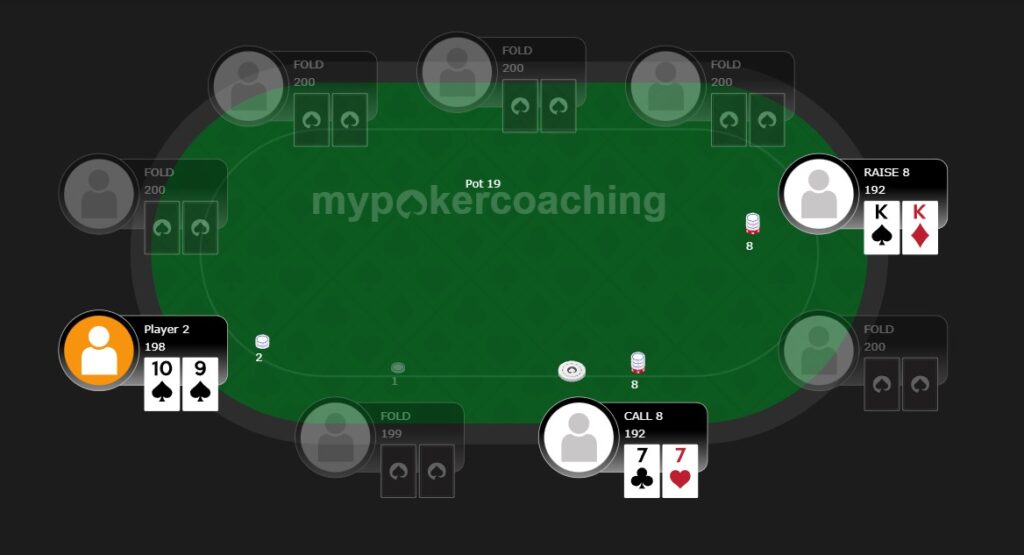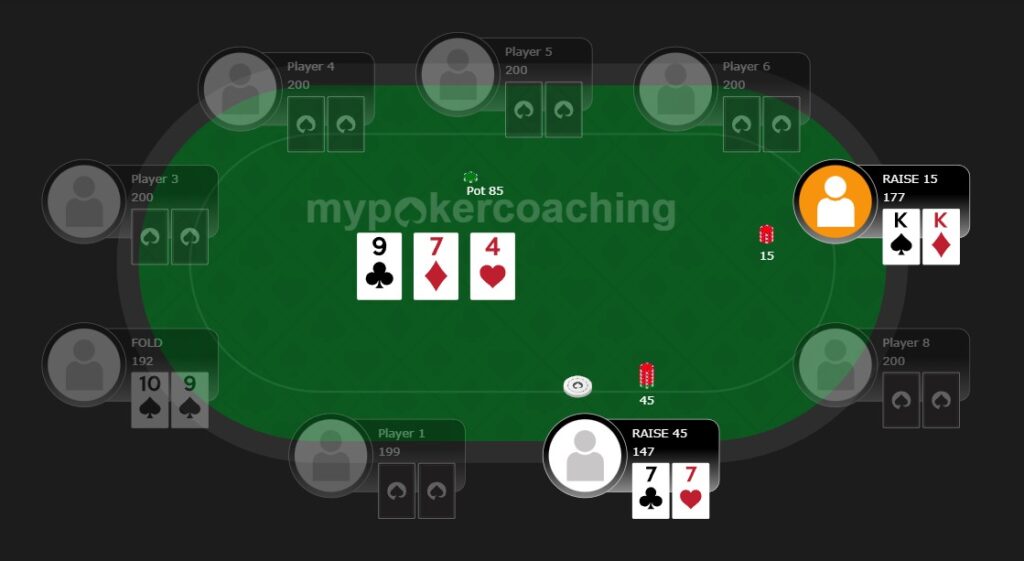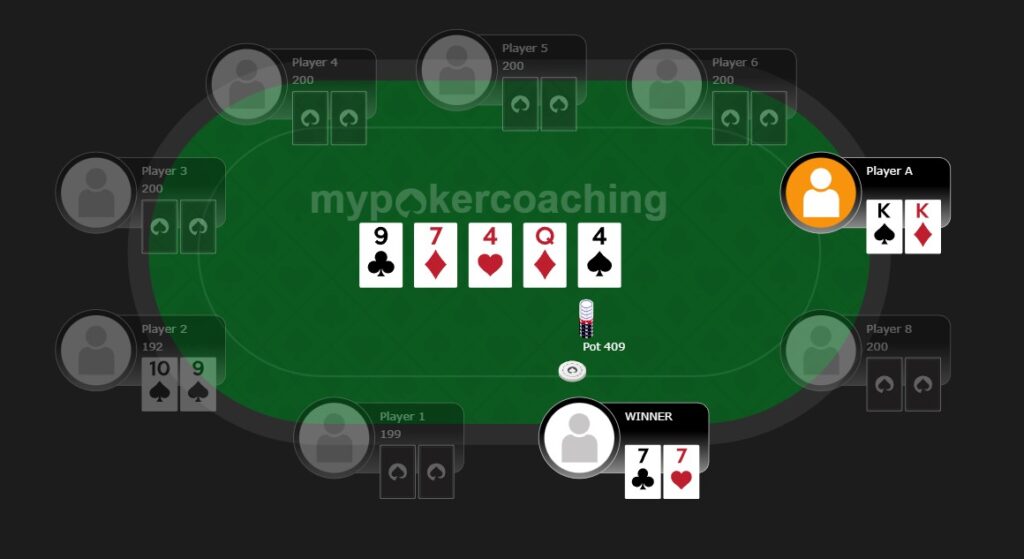If you want to learn to play Texas Hold’em Poker, you should start with the basic rules. This guide will teach you all the Texas Holdem rules, including poker hand rankings, player positions, betting rounds, and more.
We will take you on a step-by-step journey through a hand of Texas Hold’em and teach you what actions you can take, how to adjust your play according to your position, and which starting cards are worth playing.
We shall start with the very basics, so feel free to skip some parts if you are already familiar with them. However, we don’t recommend skipping too much, as it’s always worth getting a refresher course, even in concepts you already understand.
Introduction to Texas Hold’em Basics

Texas Hold’em can be played with anywhere between two and ten players seated at a poker table, and basic rules are fairly simple to learn. The good news is that you can start playing after reading this guide, even if you have never played poker before.
Here is the basic game setup:
- Before the dealing begins, a dealer button is assigned to one of the players. This button rotates around the table in a clockwise manner after every poker hand.
- The two players to the left of the dealer button post the small blind and the big blind. These are the forced bets used to drive the action.
- Two hole cards are dealt to each player at the table. These cards are private, and only turned over at the end of the hand.
- Five community cards are dealt across three streets. A total of four betting rounds are available, where players can make bets according to the value of their hand.
If more than one player reaches the final point in a hand, the hole cards are turned over to determine who has the best hand.
Sounds simple enough? Keep reading and find out how each of these elements works and make up the game of Texas Hold’em Poker.
Poker Hand Rankings
Before you can even start playing Texas Hold’em, you must understand the poker hand rankings.
In Texas Hold’em, your goal is to make the best five-card poker hand out of the seven available cards. It is possible to use any combination of the two hole cards that you get at the start of the hand and the five community cards dealt to everyone to use to make your poker hand.
The possible poker hands are as follows, from the strongest to the weakest:
| #1. Royal Flush | AsKsQsJsTs |
| #2. Straight Flush | Td9d8d7d6d |
| #3. Four of a Kind (Quads) | QsQhQcQd7s |
| #4. Full House | 8c8d8s5h5c |
| #5. Flush | AhJh8h4h2h |
| #6. Straight | 7h6s5d4c3s |
| #7. Three of a Kind (Trips) | 3d3s3hKs7c |
| #8. Two Pair | JdJh5s5cAh |
| #9.One Pair | 7h7cQd8s3h |
| #10. High Card | AcJh7d4c2s |
Ties and the Kicker
In most poker hands, one hand is the clear winner. However, the rules of Texas Hold’em allow for two players to have the same hand as well.
If the two players have the exact same hand, the hand is a tie. In this case, the two players split the pot evenly.
For example, on a board of QsJsTd7c3h, two players both hold AK. At showdown, they show their cards, and both have the Ace-high straight. This hand is a tie, and the pot is split.
However, there are other times when players have a similar hand but not quite the exact same one. In these cases, the “kicker” decides the winner.
For example, on a board of JsJd8s5c3d, two players both showdown a Jack for three of a kind. However:
- Player A shows AJ
- Player B shows KJ
Since both players have three of a kind, the highest other card in their hand, called the kicker, determines the winner.
In this case, Player A has an Ace for a kicker, while Player B has a King. The Ace pips the King, and Player A wins the hand and takes down the full pot.
If both players have the same combination according to poker hand rankings, the kicker is always used to determine the winner. The pot is only split in half when both players have the same kicker.
Texas Hold’em Rules & Hand Example
If you want to know how to play Texas Hold’em, you must also understand the actions you can take in every betting round.
There are four betting streets in a poker hand, and each time the action is on you, you can choose between several different actions.
Here are all the possible actions in the game of Texas Hold’em Poker:
- Check: Pass the action to the next player without making any bet.
- Bet: Place the first bet on a betting street.
- Fold: Discard your cards, ending participation in the hand.
- Call: Match a bet made by another player.
- Raise: Increase the size of an existing bet on a betting street.
- All-in: Bet all your chips as a bet or a raise.
If these definitions are a bit confusing, the best way to dispel the confusion is through an example. Let’s walk through an actual hand of Texas Hold’em, street by street, and see how it might look actually sitting at the table.
Preflop – The First Betting Round

The first betting street in Texas Hold’em Poker is called the preflop. This betting round starts after players receive their hole cards, and no community cards are dealt yet.
The action starts with the first player to the left of the big blind. Since the big blind is considered the first bet, each player has the option to fold, call, or raise the bet.
For our example hand, let’s imagine we are playing a $1/2 Texas Hold’em cash game, with each player sitting on $200 exactly.
With nine players at the table, four players fold before Player A looks down at a pair of Kings. They raise to $8.
The next player folds, and Player B, on the dealer button, decides to call with a pair of sevens. The small blind folds and the player in the big blind also calls with Ts9s.
Only three players stayed in the hand after the first betting round. Other players didn’t like their hole cards and elected to fold right away.
With preflop action now completed, the dealer puts out the flop, and we move to the next betting round.
Flop – The Second Betting Round

The dealer puts out a flop of 9c7d4h. The three remaining players will get to act on their hands, but the betting order is not the same as preflop.
On all betting rounds after the flop, the player in the small blind acts first. Since the small blind has folded, the big blind goes next.
The big blind has a pair of nines but decides to check his option, passing the action to the next player. Player A has a pair of Kings and likes his hand, so he bets $15 into the $25 pot.
Player B has three sevens, the second-best hand they could have on this board. He decides to raise to $45 right away, as he likes his hand and wants to get paid.
Seeing two bets in front of him, the big blind suspects he could be beaten, so he folds his nines. The player with pocket Kings makes the call, and we move on to the turn.
Turn – The Third Betting Round

Before the turn betting round can start, the dealer must put out the turn card. Only one community card is added this time around. The dealer puts out the Qd.
The order of action is the same again. There are only two players left, and Player A goes first. He checks, and his opponent now places a bet of $85.
Holding a pair of Kings, Player A is no longer sure he has the best hand, but can’t quite find a fold with such a strong hand. He decides to call once more, taking the pot up to $275.
There is one more card left before the final action.
River – The Fourth Betting Round

The dealer puts out the final community card, the river. This time, the card is the 4s, improving both players’ hands.
Player A now has two pairs, Kings and Fours, while Player B has a full house, Sevens full of Fours.
Player A checks once more, hoping to go to the showdown and win the hand. However, his opponent goes all-in, holding one of the best possible hands.
After some deliberation, Player A decides to call off his remaining chips since he is getting great odds, and they go to the showdown.
The Showdown

With all action now over, the dealer announces a showdown. The remaining players must turn over their cards in order to be eligible to win the pot.
The order in which players show depends on the river action. If there was no action on the river, the players would turn their cards in the same order in which they played on the river.
In this case, there was a bet and a call on the river. Thus, the player who took the last aggressive action must show first.
In this case, that’s Player B. He shows his pocket Sevens, and the dealer announces, “Full House.”
Player A can still turn over his cards but is also allowed to throw them into the discard pile, called muck, and forfeit the hand.
In this case, Player A shows his cards, and the dealer pushes the pot to Player B, who has the best hand with a full house. If you want to review all of the action, here is a video reply of the hand.
Texas Hold’em Hands – What Should You Play?
One of the biggest dilemmas for new poker players is which cards to play before the flop, especially when playing poker online. Most players’ first instinct is to call the big blind with many starting hands, but this is not the right approach.
Instead, poker pros choose their starting hands based on a combination of the cards and their position.
From an early position, good players play only the best starting hands, as there are so many players left to act behind them.
As they approach the big blind, players tend to play more hands, provided the players in front of them fold, as each starting hand gains relative strength.
Top 10 Starting Hands in Texas Hold’em
There are some hands in Texas Hold’em that are simply too strong to fold, even in an early position. These are the top 10 starting hands that all poker players love to see:
- Pocket Aces (AA): The strongest hand in poker, pocket Aces should be played in every situation. Whenever possible, put all the chips in before the flop with AA!
- Pocket Kings (KK): Almost as strong as AA, KK is the second-highest pocket pair and a hand you should rarely fold on the early betting streets.
- Pocket Queens (QQ): A pair of Queens is a significant downgrade from a pair of Kings, but still, a hand that’s worth a lot and should be played aggressively from all positions.
- Ace-King Suited (AKs): An Ace and a King in the same suit make for a very strong hand. This hand is arguably even better than QQ, especially with deep stacks.
- Pocket Jacks (JJ): The next pocket pair in value, JJ is not an ultimate premium, but is still worth opening from all positions and re-raising with in most cases.
- Pocket Tens (TT): A pair of Tens is similar to a pair of Jacks in many ways. Always go for an open, but be careful if facing an early position open with TT.
- Ace-Queen Suited (AQs): Similar to AKs in many ways, AQs are a premium hand in both deep stack and shallow stack situations. Be careful of getting pipped by AK.
- Pocket Nines (99): Pocket Nines is the first pocket pair that’s not a true premium. You should commit your chips with it at shallower stacks, but get more careful in deeper stack games.
- Ace-Jack Suited (AJs): Another non-premium hand that you usually want to play, AJs plays very well in tournament poker and can be a great hand to play in position in cash games.
- Pocket Eights (88): Almost identical to pocket Nines in every way, the popular “snowman” is another good starting hand in Texas Hold’em.
- King-Queen Suited (KQs): A strong Broadway combination, KQs can make straights and flushes and win a lot of big pots in deep stack situations.
Poker Positions and Hand Selection

When playing Texas Hold’em Poker, it is very important to be aware of your position. This refers to your relative position in relation to the dealer button and not your physical position at the table.
The dealer button moves around the table with every hand. This means your position also changes every hand.
The reason position is important in poker is the fact it determines who acts last after the flop. Being the last to act on postflop betting streets is a big advantage.
For this reason, holding the dealer button gives you the best position, as it guarantees you go last on every betting street. This is referred to as being “in position.”
On the other hand, the players in the small blind and big blind must always act first on every betting street after the flop. This is referred to as being “out of position.”
Here is a quick rundown of how your position in the game should affect your hand selection.
Early Position
The first two positions at a nine-handed poker table are called early positions. These positions are UTG (under the gun), and UTG+1.
Being in an early position means you play first before the flop and will be among the first to play on every subsequent street (after the blinds).
This puts you at a significant positional disadvantage. As such, you should start by playing only premium hands. Some players advocate only playing the best 10 or 15 hand combinations from these positions.
Middle Position
The next three positions at the table are the Middle positions (MP), Lojack (LJ), and Hijack (HJ).
When playing from the middle position, you can expand your poker range slightly when early position players fold their cards.
If the pot is unopened, you can play more pocket pairs, suited Aces, and suited connectors from these positions.
If facing an early position raise, you should re-raise with your strongest hands and only call with the best speculative hands.
Also, be aware of the players behind you. If there are many aggressive players still left to play, you should never just call an early position raise from the middle position.
Late Position
The Cutoff (CO) and Dealer/Button (BTN) are the best positions at the poker table. The Button is especially valuable because it guarantees absolute position against all other players.
When playing from a late position, you can expand your opening range significantly. The Dealer can often get away with playing 50% of all starting hands or more, depending on how aggressive the other players are.
Being in a late position also allows you to call more early position raises. Since you will always go last on later betting streets, you will get to realize more value when you make a big hand like a set or a straight.
The Blinds
Playing from the small blind (SB) and big blind (BB) is different from all other seats. In these positions, you are always getting a discount, as you already have money invested in the pot.
When playing in the big blind, you should look to get involved a lot against small raises. On the other hand, you should still fold most cards if facing a big raise.
In the small blind, it is recommended to re-raise or fold most of your hands. The positional disadvantage of the small blind is huge, and the discount you are getting is less significant.
Make sure to check out our preflop hand charts for a more detailed look at the opening hand ranges you should play from different starting positions.
How to Play Texas Hold’em

Now that you know the basic Texas Hold’em rules, it’s time to talk about basic strategy. We will cover some simple tips that can help you get started and compete in low-stakes poker games.
Tip #1: Understand Basic Rules & Hand Rankings
Before you can start learning any advanced poker strategies, it is important to completely master the basics, and this is why you should grab our poker cheat sheet.
Many novice players skip this step and try to learn advanced concepts without understanding the most basic ones, such as poker hand rankings. This can lead to confusion, as the essentials are necessary to progress to more complex things.
We recommend you take some time to explore the preflop hand charts, poker hand rankings, and basic poker rules before advancing to anything else.
Only once you are comfortable with all the basics of Texas Hold’em Poker should you seek deeper strategic insights.
Tip #2: Be Aware of Your Position and Play Accordingly
We already touched on the concept of position earlier in this guide. However, the importance of position cannot be overstated. In fact, it should be one of the key areas you study early in your poker career.
To start with, you should master the opening and 3-betting ranges for different stack depths in different positions. Our preflop hand charts can help you with that, as they define which hands you should play from each position.
Past that, you will want to study postflop play and the implications of being in a position or out of position on each betting street.
We recommend playing as tight as possible from early positions until you learn how to mitigate your positional disadvantage on later betting streets.
Tip #3: Start by Only Playing Strong Hands
To tie in with the previous tip, we recommend playing tight while you are learning the game. By playing only the best hands, you will avoid being put in tough spots by more skilled players.
If you are new to poker, you should only play the top 5%-10% of all hands from the earliest positions and gradually widen that range as you get closer to the dealer button.
Use the preflop hand charts as a starting point, but play a bit tighter than the charts suggest if you aren’t comfortable with postflop play.
The fewer hands you play, the more difficult postflop decisions you will have to make. As you become more comfortable with playing postflop, you will be able to expand your ranges and bring eventually play the ranges recommended in the charts.
Tip #4: Don’t Limp – Always Be the First to Raise
If preflop action gets to you and all players ahead of you have folded, either raise or fold your cards. Just calling the blind (limping) is a play you want to avoid.
By being the first one to raise, you will represent a strong range that includes the very strongest hands, and you will take the initiative in the hand.
If you raise, you will automatically force players to fold many marginal hands and tell the table that your hand is very good.
If you only raise your strong hands but limp with your speculative hands, you will be giving your opponents all the information they need about the cards you hold.
Always try to take aggressive action when possible, and use the same bet size with your stronger and weaker hands to keep your opponents on their toes.
Tip #5: Pick the Right Format for You
The game of Texas Hold’em Poker can be played in many different formats. This includes cash games, tournaments, sit and goes, spin and goes, and more.
To get the most value from the time you spend playing poker, you should learn all you can about one format and specialize in it.
For example, if you enjoy the idea of poker tournaments and competing for the elusive first-place prize, you should stick to tournaments and study tournament poker strategy. Understanding ICM, short stack adjustments, and even push fold charts will go a long way to making you a better player.
On the other hand, if you enjoy the ability to walk away from the table at any time and play whenever you feel like, study cash games and focus your efforts on this game format.
All the best poker players in the world specialize in one game format, and very few play different formats regularly.
Tip #6: Play Only When You Feel Good
Playing a lot of hands of poker is definitely important if you want to succeed. However, it is even more important to play your best game, and that’s only possible when you actually feel like playing.
If you treat poker as an obligation and something to get out of the way, it will be very easy to switch on autopilot and not think your decisions through.
This can be detrimental to your bottom line, especially if you are not yet experienced enough to make profitable decisions on a whim.
Instead, only go to the poker tables when you are rested, in a good mood, and ready to focus on every decision you make at the table like it’s the most important one you have ever made.
Tip #7: Always Keep Learning
Poker is constantly evolving, and even the best players keep studying the game and learning new things every week.
If you become complacent and stop studying poker, you will eventually reach a point where even weaker players start to become better than you as they learn new things while you remain stagnant.
There are infinite poker training sites out there these days, and you should make use of all of them, especially the free ones, to constantly improve your game and become a better poker player.
Keep these Texas Hold’em Poker tips in mind, and you will be on your way to becoming a poker master. Just remember it will take more than a few simple lessons to become a poker crusher, so always keep on learning, and the results will come.